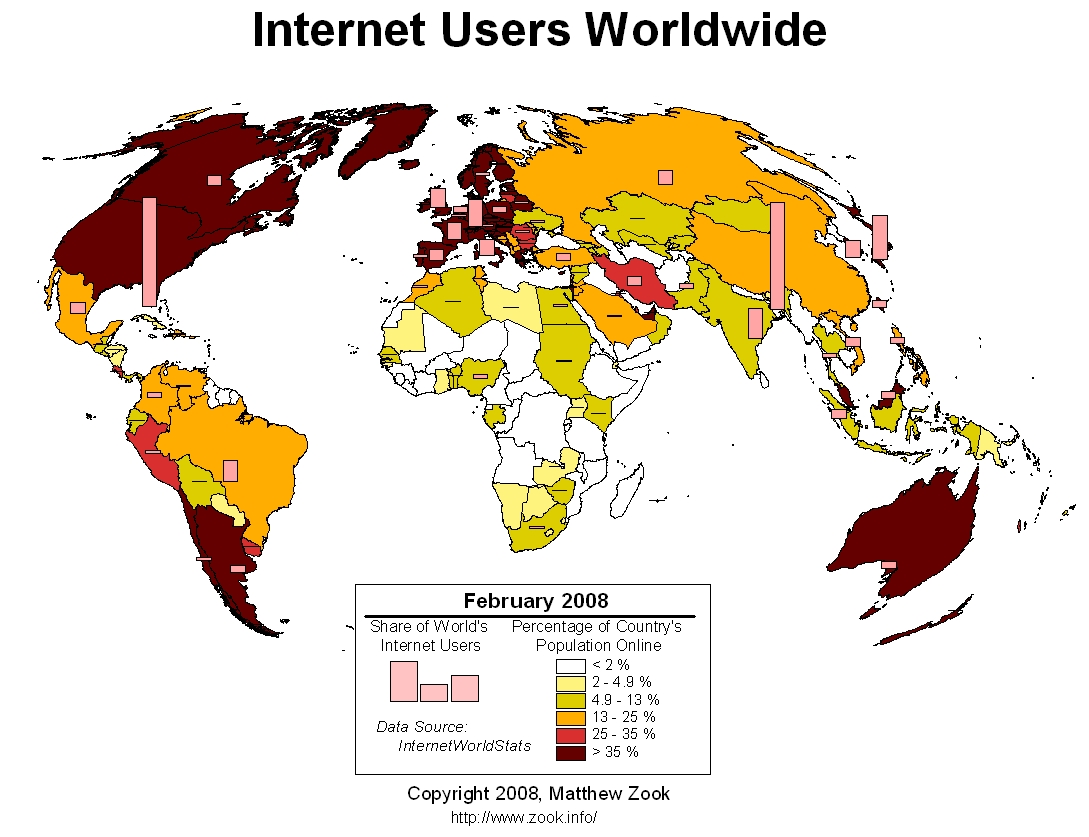Author Seth Godin introduces the “idea diffusion curve” in his book Purple Cow (p. 6) . Geoff Moore came up with the curve (imagine a typical bell curve shape) to explain how technology products move through the population.
The tip of the curve starts with a small number of “innovators,” gently swelling to include the “early adopters.” The bulk of the bell is for the “early-” and “late majority” respectively. “Laggards” make up the tail end of the curve.
A business acquaintance of mine recently referred to herself as having always been an early adopter (and perhaps more accurately an innovator). She was the first kid in her high school to have a laptop, and she’s continued in that innovator technological role ever since. Today, she is a successful businessperson who owns an online soap-making supply company (Brambleberry.com) and uses on of the newer CMC modes–Twitter–in her business. She reports this strategy is working, and she’s realizing revenue from her “tweets.”
I, on the other hand, would classify myself as a late majority or even laggard in some respects of technology. Case in point, my mother had to buy me my first cell phone and service plan. I was 32. My reluctance to take up this kind of technology was purely an economic decision. Pay for the phone and service–or go out to dinner once a month. I like to eat. I was an easy choice.
My job doesn’t require me to be very mobile, so there was no professional reason to have one. On the flip side, I was quick to jump on the high-speed Internet bandwagon as an early adopter as I viewed it an imperative for my job.
I typically make my technology choices–my haves and have nots as Neil Postman would term it–based on need and economics. If I deem that I really need a technology item, I’ll budget for it. If not, I’ll do without.
As a solidly middle-class American, if I am opting in or out of technology due to economics, how are citizen on a lower socio-economic rung able to access technology? (And when they do, are they bankrupting themselves?) Perhaps they see the trade off of NOT having technology as too great a loss.
Postman, in his Five Things We Need to Know About Technological Change speech (1998), pinpoints the lack of equal distribution of technology as one of the considerations to keep in mind when looking at advancing technology. Technological changes produce winners and losers. A current example is the decline of the print edition of newspapers. The Christian Science Monitor was the first national paper to discontinue its daily print edition in favor of solely publishing online earlier this year. Out are the pressmen, in are the Web programmers.
Thurlow et al (2008) also devote considerable thought in Strand 2, Unit 1, to the haves and have nots of technology. One of their first considerations is that technological infrastructure (the communications “road” that connects us) is a privilege. A map of the world (zooknic.com) shows that only a few counties have more than 35 percent of their population online. A majority has 25 percent or fewer online, and the poorest countries, not surprisingly, have even fewer online.
As Thurlow et al note, online equity is most often associated with economics. (Although gender, ethnicity, and language, among others, also are discriminatory factors in CMC.) Some statistics from the Thurlow text (p. 87) to consider: Two-thirds of the U.S. population is online. For those “economically privileged” (households with $75,000 at least annual income) that number rises to 90 percent. Only a handful of those with household income under $15,000 annually are online.
The concept of a “digital divide”–haves and have nots–is a reality that must not be overlooked. Security challenges aside, how can online voting really work in rural communities where there may not even be fiber optic cable laid? How many more everyday tasks may become out of reach for those without the economic and technological means?
A real life example comes from my home state of Washington where a small community was in danger of losing its library. For many of the children, the library provides the only Internet access they have. The next closest library is 10 miles away–hardly an easy bike ride to go study, noted one speaking on a local newscast.
This technological divide is one that policy makers and educators should be mindful of, especially in the tough economic times when the income gap and unemployment rates continue to grow. Our future “innovators” may become “laggards” if the digital divide becomes wide enough.
References
Godin, S. (2002). Purple Cow: Transform Your Business By Being Remarkable. New York: Portfolio.
Postman, N. (1998, March). Five Things We Need to Know About Technological Change. Speech.
Thurlow, C., Lengel, L., Tomic, A. (2008). Computer Mediated Communication: Social Interaction and the Internet. Los Angeles: Sage.

No comments:
Post a Comment